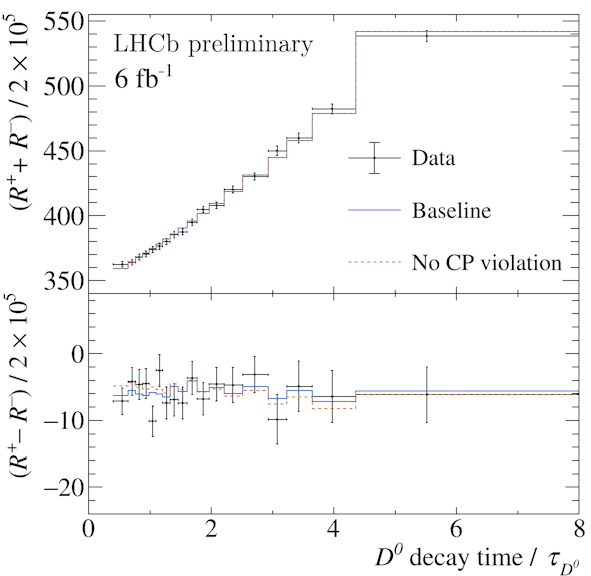Today, at a CERN seminar, the LHCb collaboration reported results of the measurement of D0 − D0 mixing and CP violation in D0→K+π– decays with the full Run 2 data sample. When combined with the previous results from Run 1, the measurement provides 40% improvement to the total uncertainty compared to the previously published analysis.
The peculiar features of quantum mechanics allow the neutral meson particles to transform into their antiparticles and back. This process is called oscillation or mixing. The frequency of oscillations is very different for Bs0− Bs0, B0– B0, D0– D0 and K0– K0 particle pairs. The Bs0− Bs0 oscillations are the fastest, about 3 million million times per second (3×1012). The oscillations B0– B0 are about 37 times slower while the oscillations D0– D0 are still slower; the oscillation period is over one hundred times larger than the average lifetime of a D0 meson as shown in the image below. Therefore only very few D0 mesons have the time to oscillate before decaying and the full oscillation period cannot be observed.

The quantum mechanical treatment of neutral charm meson oscillations leads to two neutral mesons, D1 and D2, each with their own mass, m1 and m2, and typical lifetime represented by their decay width, Γ1 and Γ2. The D0–D0 oscillations are described by the two dimensionless parameters, x=(m1-m2)/Γ, determining the frequency of oscillations, and y=(Γ1-Γ2)/Γ, in which Γ is the average width, (Γ1+Γ2)/2. The image above shows the values of x and y for different neutral mesons.
In 2019, LHCb reported the first observation of CP violation in charm decays. In 2021 LHCb reported the first observation of a nonzero mass difference, x, exploiting the D0→Ks0π+π– decay. This was one of the world’s smallest mass difference between two particles ever measured.
D0 mesons oscillations are identified as small changes in the flavour mixture (matter or antimatter) of the D0 mesons as a function of the time at which they decay. The Kπ decay, reported today, is one of the best channels to study this mixing. The initial matter-antimatter identity is identified by the charge of the accompanying pion in the decay D*+→D0π+ or D*-→ D0π–. The mixing effect (oscillation) appears as a decay-time dependence of the ratio between the number of reconstructed “wrong-sign” (WS; D0→K+π–) and “right-sign” (RS; D0→K–π+) processes. In the absence of mixing, the WS/RS ratio is predicted to be constant as a function of the D0 decay time t, while, in case of mixing, it is approximately a parabolic function of t.
The image below shows the WS/RS ratio R reported today, including both matter (R+) and antimatter (R–), and corresponding projections.

Good description of data was obtained. The mathematical analysis of the variation of this ratio with the decay time was discussed at the seminar. The variation depends not only on the oscillation parameters but also on the various observables of CP violation, the scientific term to designate differences in properties for/of matter and antimatter. No evidence for CP violation was found. Values of best parameters describing the variation of WS/RS ratio with decay time and their uncertainties can be found in the slides presented at the seminar.
The way is paved for Run 3 and beyond. LHCb plans to collect charm meson data with doubled efficiency per unit of luminosity with respect to Run 2.
Read more in the LHCb seminar, in the CERN news, and in the forthcoming paper.
